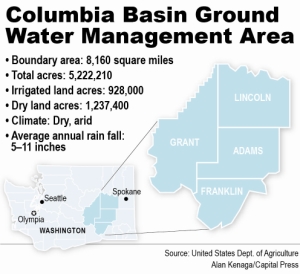forum
library
tutorial
contact

Ice Age Ground Water Vanishing
by Matthew WeaverCapital Press, October 7, 2010
|
the film forum library tutorial contact |

|
Ice Age Ground Water Vanishing
by Matthew WeaverCapital Press, October 7, 2010 |
Wells could start running dry in parts of Columbia River Basin in next decade
 A hydrologic study of part of Washington state's Columbia Basin predicts most ground water in that area could run out in the next decade.
A hydrologic study of part of Washington state's Columbia Basin predicts most ground water in that area could run out in the next decade.
The Columbia Basin Ground Water Management Area group recently began the hydrologic study to understand the recharge and discharge of groundwater in the 8,160 square miles of Adams, Lincoln, Grant and Franklin counties in Eastern Washington.
The model developed for the study evaluates the overall water "budget" for the region, which includes the number of acre-feet of water stored in the ground that wells can reasonably access, said Paul Stoker, executive director of the water management area.
It shows there were about 50 million to 60 million acre-feet of water available in the 1960s, but the amount has since declined to between 10 million and 20 million acre-feet, Stoker said. An acre-foot of water is approximately 325,851 gallons.
"What we are discovering is that the majority of the water we use is ancient, Ice Age water that is not recharging," he said. "When we reach the end of that number, we will no longer have any water. Once it's gone, it's gone."
A small percentage of the aquifers are recharged by surface water, but most will cease to produce water in the next decade, Stoker said.
The only viable option, he said, is using surface water from the Columbia River.
Overall, roughly 300,000 acres of irrigated farmland require about 900,000 acre-feet of water per year to support the crops grown in the four counties.
"There is concern that we are approaching the end of our reliable water," said farmer Roger Bailie, who represents Franklin County on the management area's board of directors.
Bailie, of Connell, Wash., hopes to see surface water replace the deep-well water on the operations his son and son-in-law own. They could lower their pumps deeper in their wells to meet a small decline in the water table, but there's a limit on how deep they can go, he said. Further pumping would only result in further aquifer depletion, he added.
On Oct. 26, the U.S. Bureau of Reclamation and Washington Department of Ecology will release a study aimed at expanding the area that can use surface water from the Columbia Basin Project. The five-year study will be discussed during the Columbia Basin Development League meeting in Moses Lake, Wash. It will look at the infrastructure needed to deliver water to that area, known as the Odessa Subarea.
"Not only are the farmers running out of water, but all of our cities are using the same water -- not a good scenario," Stoker said.
The management area does not have data for the number of farms within it. The study also covers roughly 29 cities and smaller communities within the four-county area.
Stoker said the state is pursuing the ability to supply 100,000 acres of farmland with surface water from the river. The cost will likely be addressed during the Oct. 26 presentation.
Bailie said he hopes the remedies in the study are economically feasible.
Each farmer pumping from the aquifer is in a little different circumstance, he said, but everyone has a concern.
There are about 16 subbasins in the four counties. The organization is trying to model each, Stoker said. By January, the organization also hopes to have a subbasin model completed for the Moses Lake area.
"Then we will have a much more accurate water budget able to predict, at the rate we're using, how long the water will last in that particular area," he said.
The model would also predict the results in other regions if the Odessa subarea wells are replaced by water from the river. The management area is planning future informational meetings.
"The story is ongoing," Bailie said. "We'll be working at it for a while."
Related Sites:
Columbia Basin Development League
learn more on topics covered in the film
see the video
read the script
learn the songs
discussion forum
